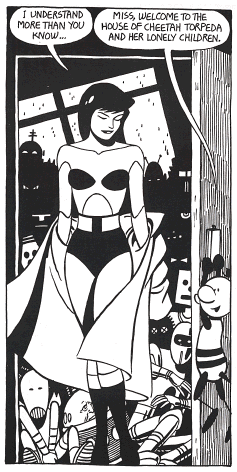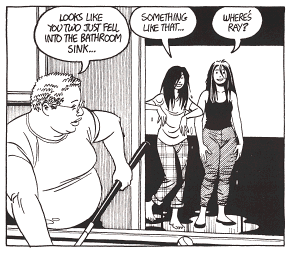

| October 1996 |
|
On the Bob Bandwagon: The town of Avon, Colorado ran a contest to name a new bridge over I-70; the winner: Bob. And Bob is running a strong second place in the official contest to rename the rump Northwest Territories after its eastern portion becomes Nunavut in 1999. Northwest Territories citizens, cast your vote for Bob! (Source: News of the Weird)
| Jaime Hernandez: Love and Rockets | |
 Love & Rockets isn't quite like anything else in comics. That may put off some readers. Where's the punchlines? Where's the pulse-pounding action sequences?
Love & Rockets isn't quite like anything else in comics. That may put off some readers. Where's the punchlines? Where's the pulse-pounding action sequences?
There's quite a few reasons to persevere past these first impressions.
The downside of all this is that Jaime's latest work is not as accessible as, oh, say, the X-Men, which you can pick up and understand in two issues, and put down for five years, knowing that when you get back to it it'll be much the same, only worse. Plus L&R only came out 3 or 4 times a year, so it was easy to lose the thread.
The solution here is to read the trade paperbacks from Fantagraphics. Jaime reads much better in collected form anyway. (Also, if you get lost, check out my chronology and character index.)
Here's my recs on the best of Jaime:
The best of Jaime's early stories are "100 Rooms," "Mechan-X," and "The Lost Women". An easy way to get all three stories, plus a bunch of short stories, is in the digest-size all-Jaime books, Love & Rockets and The Lost Women. To find all three in the larger TPBs, you'll have to pick up 3 books: Music for Mechanics, Chelo's Burden, and Las Mujeres Perdidas. Or instead of the first two books, get the magazine itself, issues #1 to #4; it's cheaper.
These stories had more of a sf feel: Maggie and Hopey seem to live in an alternate world where Los Angeles is exactly as it is today, but the rest of the world contains robots, rockets, monsters, and superheroes. But Jaime reverses the Marvel Comics modus operandi: instead of adventure with a little ordinary life thrown in here and there, he writes about the day to day lives of his protagonists, with the adventure pushed firmly into the background, and treated with a careless parodic air.
So: "100 Rooms," is set in a millionaire's mansion and features a kidnapper who claims to be the "true heir to the throne of Drussia"; but what it's about is Maggie's devotion to Hopey. Like everything else in Jaime's work, their relationship doesn't fit into easy slots. It's a lesbian love affair, yet Maggie continues to have crushes on (usually inaccessible) men. Hopey doesn't seem to mind (even though she's given up a previous girlfriend, Terry, for Maggie), but she's not into monogamy either.
In "The Lost Women" Maggie and wrestling champ Rena Titañon are caught up in a revolution. To the extent that we see the causes, it's a worthy fight; yet what we see of all sides is a misfiring of foolishness and overreaction, leading ultimately to tragedy.
With this story Jaime delves into the severest social realism. The focus is a gang war, or more precisely the little stupidites and banalities that lead up to it. The sensation of inevitable catastrophe (resisted by some of the characters, wittingly or unwittingly assisted by some of the others) is overwhelming.
The similarity to the L.A. Latino-gang movie of a few years back, Mi Vida Loca, is striking, and confirms the essential accuracy of Jaime's reporting. The movie was pretty much a downer: the girls in the movie don't have anything to get them away from the brutal ethos of the gang life. You sense why the punk scene (not to mention Maggie's mechanics jobs) was a liberation for Maggie and Hopey.
 Wigwam Bam was the first Jaime I read. I was fascinated, and also baffled-- I didn't know all these people, I couldn't even tell when we were in a flashback.
Wigwam Bam was the first Jaime I read. I was fascinated, and also baffled-- I didn't know all these people, I couldn't even tell when we were in a flashback.
The two books together really form a single work, a 278-page extended riff on Maggie and Hopey, who they are together and apart, for themselves and their extended web of family and friends. The double book begins with their breakup, and ends with their tentative reunion; the first centers on Hopey, the second on Maggie-- centers, but not so tightly as to lose a dozen peripheral stories: Danita and her boyfriend Ray, Danita's job as a stripper (nowhere near as glamorous as Omaha's), Isabel's obsessions, the sex games of an old lady, several characters' infatuations with Hopey or Maggie, and all the women wrestlers you could possibly want.
If the earlier stories are more or less about the intoxication of adolescence, these works are more about the twenties, about the difficult process of getting a life-- a time when sex, partying, punk rock, and getting away from the fam are no longer enough for happiness, but when settling down seems neither possible nor very attractive.
So what about Gilberto, the other half of the comic book? Am I going to do a chronology of his work? (God knows it needs one.)
Well, no. I'm just not as much into Beto's work. I did like his very earliest work, "BEM" (L&R #1)-- an affectionate takeoff on sf and horror movie clichés-- and "Heartbreak Soup," a marvelous tale of adolescence, first love, and life and death in a small town. At his best Beto has an uncanny grasp of how teenagers talk, fight, and discover the world.
Part of it is just that I haven't read the whole Palomar epic, and so some of the later portions just confuse me or don't hold my interest. And some of what I like about Jaime is lacking in Beto. The art isn't as polished. I don't share Beto's interest in hypertrophied breasts. And I prefer Jaime's realism. Jaime, after all, did grow up in SoCal, is a Mexican-American, did get turned on by punk and play in a band. Palomar is not reporting; it's a fantasy. If you want the real scoop on living in a small Mexican town, read Mis Supermachos, by the Mexican comics artist Rius. Hint: it's not a happy matriarchy.
